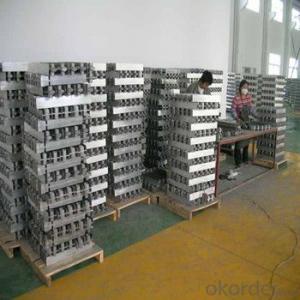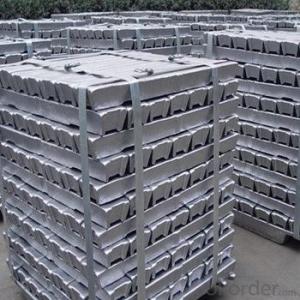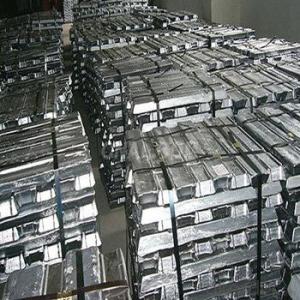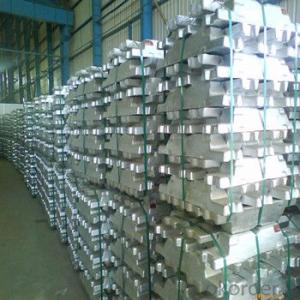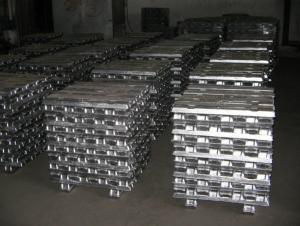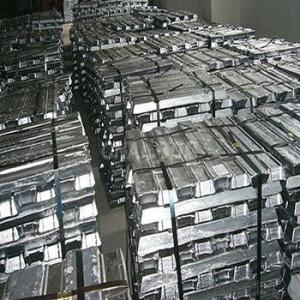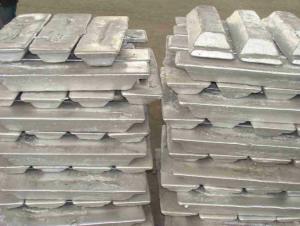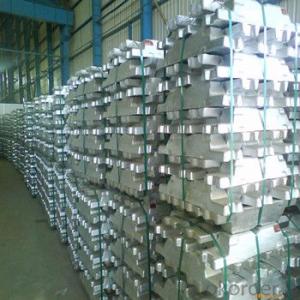Aluminium Ingot Al99.70 From Good Factory
- Loading Port:
- China main port
- Payment Terms:
- TT OR LC
- Min Order Qty:
- 1000 m.t.
- Supply Capability:
- 10000 m.t./month
OKorder Service Pledge
OKorder Financial Service
You Might Also Like
Pure Aluminum Ingot Used for Industry
1.Structure of Aluminum Ingot Description
A material that has been cast into a shape in order to be transported and processed easier than in an unprocessed form. An ingot is typically rectangular in shape, which allows it to be stacked. Ingots are most commonly associated with metals, with ingots of gold held in the vaults of banks and brokerages being popular images.
2.Main Features of the Aluminum Ingot
•High Purity
•High strength
•Fast melting
•Best price
•Good after-service
3. Aluminum Ingot Images
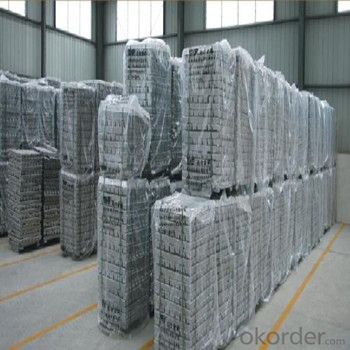
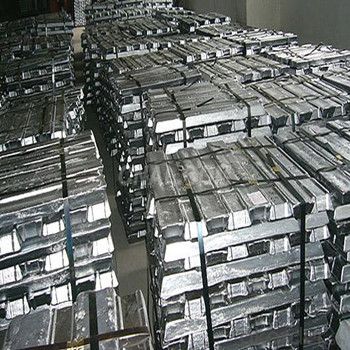
4. Aluminum Ingot Specification
Grade | Chemical Composition % | |||||||||
Al≥ | impurities ≤ | |||||||||
Si | Fe | Cu | Ga | Mg | Zn | Mn | others | Sum | ||
Al99.9 | 99.90 | 0.50 | 0.07 | 0.005 | 0.02 | 0.01 | 0.025 | - | 0.010 | 0.10 |
Al99.85 | 99.85 | 0.80 | 0.12 | 0.005 | 0.03 | 0.02 | 0.030 | - | 0.015 | 0.15 |
Al99.7 | 99.70 | 0.10 | 0.20 | 0.010 | 0.03 | 0.02 | 0.030 | - | 0.030 | 0.30 |
Al99.6 | 99.60 | 0.16 | 0.25 | 0.010 | 0.03 | 0.03 | 0.030 | - | 0.030 | 0.40 |
Al99.5 | 99.50 | 0.22 | 0.30 | 0.020 | 0.03 | 0.05 | 0.050 | - | 0.030 | 0.50 |
Al99.00 | 99.00 | 0.42 | 0.50 | 0.020 | 0.03 | 0.05 | 0.050 | - | 0.050 | 1.00 |
5.FAQ of Aluminum Ingot
We have organized several common questions for our clients,may help you sincerely:
①How about your company?
A world class manufacturer & supplier of castings forging in carbon steel and alloy steel,is one of the large-scale professional investment casting production bases in China,consisting of both casting foundry forging and machining factory. Annually more than 8000 tons Precision casting and forging parts are exported to markets in Europe,America and Japan. OEM casting and forging service available according to customer’s requirements.
②How to guarantee the quality of the products?
We have established the international advanced quality management system,every link from raw material to final product we have strict quality test;We resolutely put an end to unqualified products flowing into the market. At the same time, we will provide necessary follow-up service assurance.
③How long can we receive the product after purchase?
In the purchase of product within three working days, We will arrange the factory delivery as soon as possible. The pecific time of receiving is related to the state and position of customers.Commonly 7 to 10 working days can be served.
- Q:Does aluminum ingots produced without aluminum ore belong to metal smelting?
- Metal smelting is the process of changing metal from a compound to a free state.Metal elements were obtained by reduction reaction with metal oxides such as carbon, carbon monoxide, hydrogen and other reducing agents at high temperature.
- Q:Who knows, general aluminium ingot has those specifications?
- Several common aluminum ingotAluminum ingots for remelting --15kg (99.80%Al, 20kg):T shaped aluminum ingot --500kg, 1000kg (99.80%Al):High purity aluminium ingot --l0kg, 15kg (99.90% ~ 99.999%Al);Aluminium alloy ingots --10kg, 15kg (Al--Si, Al--Cu, Al--Mg);Slab --500 to 1000kg (for plate making);Round ingot --30 to 60kg (wire drawing).
- Q:What are the challenges in recycling scrap aluminum ingots?
- One of the challenges in recycling scrap aluminum ingots is the presence of impurities and contaminants. These impurities can affect the quality of the recycled aluminum and may require additional processing steps to remove them effectively. Additionally, the collection and sorting of scrap aluminum can be challenging due to its widespread use in various industries, leading to difficulties in sourcing sufficient quantities of clean and uncontaminated scrap material. Finally, the energy-intensive nature of aluminum production and recycling poses a challenge in terms of the environmental impact and cost-effectiveness of the recycling process.
- Q:What are the limitations of using aluminum ingots in high-temperature applications?
- There are several limitations associated with using aluminum ingots in high-temperature applications. Firstly, aluminum has a relatively low melting point of around 660 degrees Celsius. This means that it may not be able to withstand extremely high temperatures typically encountered in some industrial processes or aerospace applications. At such elevated temperatures, aluminum tends to soften and lose its mechanical strength, which can compromise the integrity and functionality of the component or structure. Secondly, aluminum has a high coefficient of thermal expansion. This means that it expands significantly when exposed to heat. This expansion can lead to dimensional instability and can cause issues such as warping or distortion of the component, especially when subjected to rapid or uneven heating and cooling cycles. These dimensional changes can affect the accuracy of the final product and may require additional measures to compensate for the thermal expansion. Additionally, aluminum has relatively poor resistance to oxidation at high temperatures. When exposed to oxygen at elevated temperatures, aluminum can form a thin layer of aluminum oxide, which can act as a barrier and protect the underlying metal from further oxidation. However, at extremely high temperatures, this protective layer can break down, leading to increased susceptibility to oxidation and corrosion. This can result in a reduction in the strength and durability of the aluminum component. Lastly, aluminum has a relatively low strength compared to other materials such as steel or titanium. While aluminum alloys can be developed to enhance their strength, they still may not be suitable for applications requiring exceptional strength at high temperatures. In situations where high mechanical strength is crucial, alternative materials with better high-temperature strength properties may be more suitable. In summary, the limitations of using aluminum ingots in high-temperature applications include its low melting point, high coefficient of thermal expansion, susceptibility to oxidation, and relatively low strength. These factors need to be carefully considered when selecting materials for high-temperature applications to ensure the desired performance and reliability of the components or structures.
- Q:What are the different methods for machining aluminum ingots?
- There are several different methods for machining aluminum ingots, depending on the desired shape, size, and accuracy required for the final product. Some of the common methods include: 1. Milling: This is a process where a rotating cutter removes material from the ingot to create the desired shape. It is suitable for creating flat surfaces, slots, and holes. 2. Turning: In this method, the ingot is rotated while a cutting tool removes material to create cylindrical shapes. Turning can be used to create shafts, rods, and other cylindrical components. 3. Drilling: Drilling is a process where a rotating tool with cutting edges is used to create holes in the aluminum ingot. It is commonly used to create holes of various sizes and depths. 4. Grinding: Grinding involves using abrasive wheels or belts to remove material from the ingot's surface, creating a smooth and precise finish. It is often used to achieve tight tolerances and precise dimensions. 5. Sawing: Sawing is a process where a saw blade cuts through the aluminum ingot to create desired shapes or separate the ingot into smaller pieces. It is commonly used for cutting aluminum ingots into bars or smaller billets. 6. Waterjet cutting: Waterjet cutting uses a high-pressure stream of water mixed with abrasive particles to cut through the aluminum ingot. This method can create complex shapes and does not generate heat, making it suitable for cutting delicate or heat-sensitive materials. 7. Electrical discharge machining (EDM): EDM is a process that uses electrical sparks to remove metal from the aluminum ingot. This method is often used for intricate or detailed shapes that are difficult to achieve with conventional machining methods. It is important to select the appropriate machining method based on the specific requirements of the aluminum ingot and the desired final product. Factors such as the ingot's size, shape complexity, tolerance requirements, and material characteristics will influence the choice of machining method.
- Q:How much is a ton of aluminium ingots now?
- Futures: the Fed announced interest rate hike, the dollar frustrated, overnight aluminum rose $23 to $1884 / ton; Shanghai aluminum night plate affected by the outer disk, the strong side of the shock operation;
- Q:What are the main factors influencing the choice between aluminum ingots and aluminum castings?
- The main factors influencing the choice between aluminum ingots and aluminum castings are the desired shape and complexity of the final product, manufacturing process efficiency, cost considerations, and the mechanical properties required for the application.
- Q:Want to do a scrap processing of aluminum ingots of small workshops, about investment of about 100 thousand, the specific process, need what equipment technology, please expert advice
- Because it is profit, a ton of scrap, more of a water, is 160 dollars. The equipment is also very critical, when bad equipment in the melting scrap loss is large, so the water rate is down. Experienced and inexperienced, the difference in the rate of effluent can be 10 points. It is suggested that on-the-spot investigation should be conducted with prudent investment.
- Q:What are the basic equipments for the production of aluminium ingots?
- Pay attention to points can also be added on the basis of: mixing equipment, feeding equipment, sorting equipment, online degassing, etc..
- Q:How are aluminum ingots used in the aerospace industry?
- The aerospace industry extensively utilizes aluminum ingots because of their numerous advantageous properties. These ingots are melted and cast into different components, such as aircraft frames, wings, fuselage, and engine parts. The primary reason for using aluminum ingots is their lightweight characteristic. Aluminum is notably lighter than other metals, like steel, while still maintaining high strength and durability. This weight advantage contributes to improved fuel efficiency and increased payload capacity, making it an excellent choice for aircraft manufacturing. Furthermore, aluminum ingots possess exceptional corrosion resistance properties. This is crucial for aerospace applications, as aircraft are exposed to various environmental factors, including moisture and other corrosive substances. The corrosion resistance of aluminum guarantees the aircraft's longevity and structural integrity, reducing maintenance and repair costs. Moreover, aluminum ingots offer outstanding thermal conductivity. This property enables efficient heat dissipation, particularly in engine components that generate high temperatures. The ability to transfer heat away from critical parts helps prevent overheating and ensures optimal performance. Additionally, aluminum ingots can be easily machined and fabricated into complex shapes, making them adaptable to various design requirements. This versatility allows engineers to create intricate components with precise dimensions, enhancing the overall efficiency and performance of the aircraft. In conclusion, the aerospace industry relies on aluminum ingots due to their lightweight nature, corrosion resistance, thermal conductivity, and ease of fabrication. These properties make them an ideal material for constructing aircraft components, contributing to fuel efficiency, durability, and overall performance.
1. Manufacturer Overview |
|
|---|---|
| Location | |
| Year Established | |
| Annual Output Value | |
| Main Markets | |
| Company Certifications | |
2. Manufacturer Certificates |
|
|---|---|
| a) Certification Name | |
| Range | |
| Reference | |
| Validity Period | |
3. Manufacturer Capability |
|
|---|---|
| a)Trade Capacity | |
| Nearest Port | |
| Export Percentage | |
| No.of Employees in Trade Department | |
| Language Spoken: | |
| b)Factory Information | |
| Factory Size: | |
| No. of Production Lines | |
| Contract Manufacturing | |
| Product Price Range | |
Send your message to us
Aluminium Ingot Al99.70 From Good Factory
- Loading Port:
- China main port
- Payment Terms:
- TT OR LC
- Min Order Qty:
- 1000 m.t.
- Supply Capability:
- 10000 m.t./month
OKorder Service Pledge
OKorder Financial Service
Similar products
New products
Hot products
Related keywords
